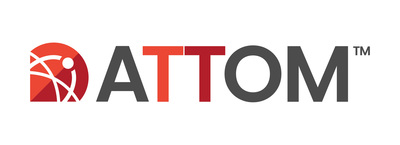
Home prices rose in 54.6 percent of census tracts inside and outside Opportunity Zones in third quarter.
IRVINE, Calif., Nov. 6, 2025 /PRNewswire/ — ATTOM, a leading curator of land, property data, and real estate analytics, today released its third-quarter 2025 report analyzing qualified low-income Opportunity Zones targeted by Congress for economic redevelopment in the Tax Cuts and Jobs Act of 2017 (see full methodology below). In this report, ATTOM looked at 3,724 zones around the United States with sufficient data to analyze, meaning they had at least five home sales in the third quarter of 2025.
The analysis found that median single-family home and condo prices rose quarter-over-quarter in half (49.7 percent) of the Opportunity Zones with sufficient data in both quarters. Compared to the third quarter of 2024, median home prices rose in 54.6 percent of Opportunity Zones.
The third quarter of 2025 saw 11.3 percent of opportunity zones (422) hit their highest median home price since the Great Recession in 2008. And typical home prices rose by at least 10 percent year-over-year in 36.2 percent of Opportunity Zones with sufficient data to analyze.
“Opportunity Zones were just as likely to see home prices grow as neighborhoods outside these zones, showing these areas are also benefitting from this sustained rise in home prices,” said Rob Barber, CEO of ATTOM. “But many of these zones still have a long way to go, since their median sales prices are well below areas that haven’t been targeted for development”
Opportunity Zones are defined in the Tax Act legislation as census tracts in or alongside low-income neighborhoods that meet various criteria for redevelopment in all 50 states, the District of Columbia and U.S. territories. Census tracts, as defined by the U.S. Census Bureau, cover areas that have 1,200 to 8,000 residents, with an average of about 4,000 people.
Median home prices also rose in 54.6 percent of census tracts outside of Opportunity Zones, meaning that tracts inside the zones were equally as likely to see price growth as those outside the zones.
However, median prices inside Opportunity Zones continue to be much lower than those outside. The typical home sales price was above the national median of $370,000 in only 20 percent of Opportunity Zone tracts.
Half of the Opportunity Zone census tracts (49.9 percent) had median sales prices below $225,000 in the third quarter of 2025.
Due to the small number of sales in many Opportunity Zones, median price measurements can be very volatile. The typical sales prices rose or fell by more than 5 percent year-over-year in 80 percent of Opportunity Zone tracts.
Major findings from the report:
- Median prices for single family homes and condos rose from the second to the third quarter of 2025 in 49.7 percent (1,644) of the 3,311 Opportunity Zones with sufficient data in both quarters. Year-over-Year, median prices rose in 54.6 (1,827) of the 3,346 Opportunity Zones with sufficient data.
- Home prices rose year-over-year in the same share of tracts outside of Opportunity Zones: 54.6 percent (30,213) of 55,379 tracts with sufficient data.
- A higher share of tracts inside Opportunity Zones (36.2 percent) saw median prices grow by more than 10 percent year-over-year compared to tracts outside (31.6 percent).
- Opportunity Zones with the lowest median home values were also least likely to see price growth, with only 39.7 percent of zones where the median sales price was less than $125,000 experiencing year-over-year growth.
- Among states with at least 25 Opportunity Zones with sufficient data to analyze, Arkansas had the highest share of Opportunity Zones where median home prices grew year-over-year (median prices rose in 76 percent of the state’s Opportunity Zones). It was followed by New York (prices rose in 71.4 percent of zones), Minnesota (prices rose in 67.2 percent of zones); Alabama (prices rose in 65.2 percent of zones); and Iowa (prices rose in 64.7 percent of zones).
- Typical home prices inside Opportunity Zones tended to be lower than outside. Only 20 percent of Opportunity Zone tracts had median sales prices above the national median of $370,000.
- Most Midwestern Opportunity Zones (54 percent) had median home values below $175,000, compared to 38 percent in the Northeast, 37 percent in the South, and 5 percent in the West.
Conclusion
ATTOM’s Q3 2025 Opportunity Zones Report reveals that home prices in Opportunity Zones rose at the same pace as the rest of the nation in the third quarter of 2025, increasing year-over-year in 54.6 percent of zones analyzed and matching the share of growth in non-Opportunity Zone areas. More than a third (36.2 percent) of zones saw prices jump by at least 10 percent from a year earlier, and over 11 percent hit their highest median price since the Great Recession in 2008. Despite these gains, homes inside Opportunity Zones remain far more affordable, with only 20 percent of tracts posting median prices above the national median of $370,000.
Report methodology
The ATTOM Opportunity Zones analysis is based on home sales price data derived from recorded sales deeds. Statistics for previous quarters are revised when each new report is issued as more deed data becomes available. ATTOM’s analysis compared median home prices in census tracts designated as Opportunity Zones by the Internal Revenue Service. Except where noted, tracts were used for the analysis if they had at least five sales in the second quarter of 2025. Median household income data for tracts and counties comes from surveys taken by the U.S. Census Bureau (www.census.gov) from 2019 through 2023. The list of designated Qualified Opportunity Zones is located at U.S. Department of the Treasury. Regions are based on designations by the Census Bureau. Hawaii and Alaska, which the bureau designates as part of the Pacific region, were included in the West region for this report.
About ATTOM
ATTOM
powers innovation across industries with premium property data and analytics covering 158 million U.S. properties—99% of the population. Our multi-sourced real estate data includes property tax, deed, mortgage, foreclosure, environmental risk, natural hazard, neighborhood and geospatial boundary information, all validated through a rigorous 20-step process and linked by a unique ATTOM ID.
From flexible delivery solutions—such as Property Data APIs, Bulk File Licenses, Cloud Delivery, Real Estate Market Trends—to AI-Ready datasets, ATTOM fuels smarter decision-making across industries including real estate, mortgage, insurance, government, and more.
Media Contact:
Megan Hunt
[email protected]
Data and Report Licensing:
949.502.8313
[email protected]
View original content to download multimedia:https://www.prnewswire.com/news-releases/opportunity-zone-home-price-growth-matches-rest-of-nation-302607041.html
SOURCE ATTOM



